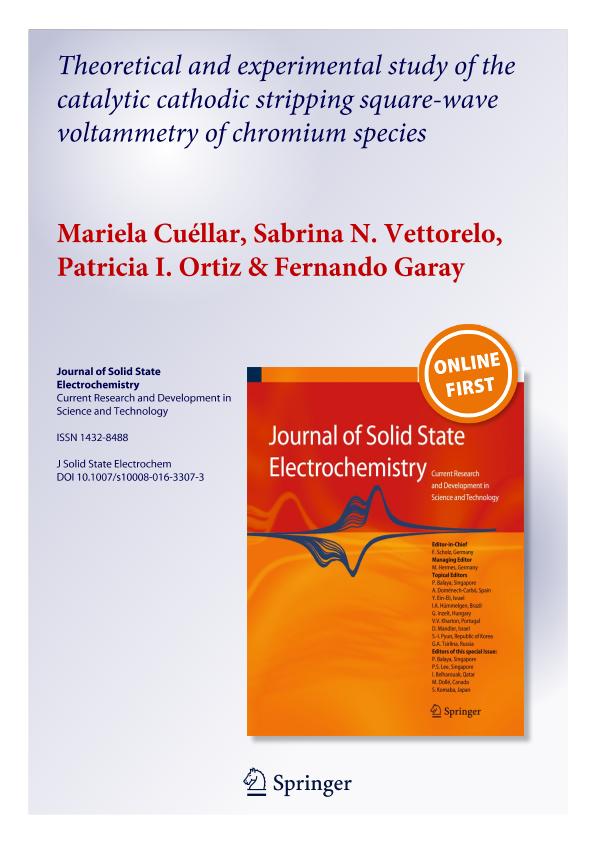Mostrar el registro sencillo del ítem
dc.contributor.author
Cuellar, Mariela

dc.contributor.author
Vettorelo, Sabrina Noel

dc.contributor.author
Ortiz, Patricia Ines

dc.contributor.author
Garay, Fernando Sebastian

dc.date.available
2018-10-11T20:45:38Z
dc.date.issued
2016-12
dc.identifier.citation
Cuellar, Mariela; Vettorelo, Sabrina Noel; Ortiz, Patricia Ines; Garay, Fernando Sebastian; Theoretical and experimental study of the catalytic cathodic stripping square-wave voltammetry of chromium species; Springer; Journal of Solid State Electrochemistry (print); 20; 12; 12-2016; 3279-3286
dc.identifier.issn
1432-8488
dc.identifier.uri
http://hdl.handle.net/11336/62251
dc.description.abstract
The electrocatalytic mechanism of Cr(III) reduction in the presence of diethylenetriaminepentaacetic acid (DTPA) and nitrate ions is studied theoretically and experimentally by using stripping square-wave voltammetry (SWV). Experimental curves are in excellent agreement with theoretical profiles corresponding to a catalytic reaction of second kind. This type of mechanism is equivalent to a CE mechanism, where the chemical reaction produces the electroactive species. Accordingly, the reaction of Cr(III)–H2O–DTPA and NO3- would produce the electroactive species Cr(III)–NO3–DTPA and this last species would release NO2- to the solution during the electrochemical step. In this regard, the complex of Cr(III)–DTPA would work as the catalyzer that allows the reduction of NO3- to NO2-. Furthermore, it was found that the electrochemical reaction is quite irreversible, with a constant of ks = 9.4 × 10−5 cm s−1, while the constant for the chemical step has been estimated to be kchem = 1.3 × 104 s−1. Considering that the equilibrium constant is K = 0.01, it is possible to estimate the kinetic constants of the chemical reaction as k1 = 1 × 102 s−1 and k−1 = 1.29 × 104 s−1. These values of k1 and k−1 indicate that the exchange of water molecules by nitrate is fast and that the equilibrium favors the complex with water. Also, a value for the formal potential E°’ ≈ −1.1 V was obtained. The model used for simulating experimental curves does not consider the adsorption of reactants yet. Accordingly, weak adsorption of reagents should be expected.
dc.format
application/pdf
dc.language.iso
eng
dc.publisher
Springer

dc.rights
info:eu-repo/semantics/openAccess
dc.rights.uri
https://creativecommons.org/licenses/by-nc-sa/2.5/ar/
dc.subject
Catalysis of Second Type
dc.subject
Catalytic
dc.subject
Ce Mechanism
dc.subject
Cr Speciation
dc.subject
Dtpa
dc.subject
Mathematical Modelling
dc.subject
Square-Wave Voltammetry
dc.subject.classification
Otras Ciencias Químicas

dc.subject.classification
Ciencias Químicas

dc.subject.classification
CIENCIAS NATURALES Y EXACTAS

dc.title
Theoretical and experimental study of the catalytic cathodic stripping square-wave voltammetry of chromium species
dc.type
info:eu-repo/semantics/article
dc.type
info:ar-repo/semantics/artículo
dc.type
info:eu-repo/semantics/publishedVersion
dc.date.updated
2018-09-10T15:47:28Z
dc.journal.volume
20
dc.journal.number
12
dc.journal.pagination
3279-3286
dc.journal.pais
Alemania

dc.journal.ciudad
Berlin
dc.description.fil
Fil: Cuellar, Mariela. Consejo Nacional de Investigaciones Científicas y Técnicas. Centro Científico Tecnológico Conicet - Córdoba. Instituto de Investigaciones en Físico-química de Córdoba. Universidad Nacional de Córdoba. Facultad de Ciencias Químicas. Instituto de Investigaciones en Físico-química de Córdoba; Argentina
dc.description.fil
Fil: Vettorelo, Sabrina Noel. Consejo Nacional de Investigaciones Científicas y Técnicas. Centro Científico Tecnológico Conicet - Córdoba. Instituto de Investigaciones en Físico-química de Córdoba. Universidad Nacional de Córdoba. Facultad de Ciencias Químicas. Instituto de Investigaciones en Físico-química de Córdoba; Argentina
dc.description.fil
Fil: Ortiz, Patricia Ines. Consejo Nacional de Investigaciones Científicas y Técnicas. Centro Científico Tecnológico Conicet - Córdoba. Instituto de Investigaciones en Físico-química de Córdoba. Universidad Nacional de Córdoba. Facultad de Ciencias Químicas. Instituto de Investigaciones en Físico-química de Córdoba; Argentina
dc.description.fil
Fil: Garay, Fernando Sebastian. Consejo Nacional de Investigaciones Científicas y Técnicas. Centro Científico Tecnológico Conicet - Córdoba. Instituto de Investigaciones en Físico-química de Córdoba. Universidad Nacional de Córdoba. Facultad de Ciencias Químicas. Instituto de Investigaciones en Físico-química de Córdoba; Argentina
dc.journal.title
Journal of Solid State Electrochemistry (print)

dc.relation.alternativeid
info:eu-repo/semantics/altIdentifier/doi/https://dx.doi.org/10.1007/s10008-016-3307-3
dc.relation.alternativeid
info:eu-repo/semantics/altIdentifier/url/https://link.springer.com/article/10.1007/s10008-016-3307-3
Archivos asociados
